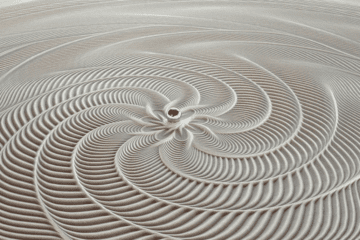There’s nothing easy in a desert — food, water, shelter… filmmaking. Sand and dust, while obviously expected, aren’t the only elements you have to worry about — there’s also incredible heat. Shooting a movie in a desert means not only protecting the camera from all this, but also yourself and the rest of the equipment.
1. Sand-Proof Everything
Camera:
- Use an optical flat to protect the lens
- Cover the camera when possible
- Put gear not being used in the shade
- Keep an eye on the camera’s temperature
- Clean your gear at least everyday
a. Use an optical flat to protect the lens
Putting a filter in front of the lens keeps it shielded from any dust kicked up by movement in the desert. It’s also easier to clean a filter than it is a lens and filters are cheaper to replace should scratches result from the wear and tear.
If you don’t have an optical flat, use an IR or Hot Mirror filter instead — basically, any filter that won’t affect the stop you expose the image to. In many cases, you will likely be using Neutral Density filters which will also provide protection.
b. Cover the camera when possible
I love space blankets — designed to contain warmth or shield from heat — and you should definitely have one in your toolkit. That way, between long setups, you can cover the camera with the reflective side of the blanket out.
This will reduce the camera’s chance of overheating since most camera bodies are colored sunlight-sucking black. Or you can also…
c. Put gear not being used in the shade
I have yet to work on a film that doesn’t have at least one pop-up tent at its disposal. These are quick, deployable covers that create instant shade.
If you have access to one, put your camera cart or gear underneath it. It’s not good for the gear to bake in the sun (plus if you’re using metal cases, they can heat up and burn you when you go to open them).
If you don’t have a pop-up, kindly ask the grips to make you a courtesy flag to create shade.
d. Keep an eye on the temperature of the camera
Most cameras have temperature control, fans, and cooling vents to keep temperature down, but they are still highly susceptible to over-heating. Once the temperature gets into a danger zone, alert the director of photography and production and shut it down. Not only does over-heating damage internal components, but it can also add noise to the image.
Having ice packs on hand — placed inside a ziplock bag to protect from condensation — is also advised to cool it down faster.
e. Clean your gear at least everyday
No matter how hard you try to prevent it, the desert sand/dust will end up anywhere and everywhere on the camera. It’s crucial you clean it at the end of everyday, preferably away from the dusty environment.
Use a camel hair brush for delicate areas, compressed air or a blower for large areas of dust, and the appropriate methods when doing so. Check lenses and filters religiously and clean them, if needed, before dust settles onto them. (People also say it’s best not to use the blower, but use a vacuum instead.)
Computer:
2. Take care of yourself:
- Have proper protection from the sun (Sunscreen + create a shelter)
- Drink lots of water (3-4 liters a day)
- Wear neutral colors (NOT White, light colors that does not reflect the light)
- Bring a basic survival and first aid kit
3. Film Permits in Abu Dhabi
https://www.film.gov.ae/en/filming-in-abu-dhabi/permits/
Also drone permits. To avoid restrictions and permits, hire a registered local drone operator to film in a very limited area.
4. Utilize the local resources
- Hire a local experienced driver
- Rent air-conditioned tents and blankets from nearby
- Food catering & camel herders (?)
5. Timings
November to April. Temperatures during this period are around 24C (75F) during the day.
Sunrise – 11am, 3pm – sunset.
6. Best Spot and Best Lighting
Locations in Abu Dhabi: https://www.twofour54.com/en/media-centre/blog/highlights/best-desert-filming-locations-in-abu-dhabi/
- Eastern Mangrove Nature Park
The Environment Agency Abu Dhabi protects one of the Emirate’s most critical ecological assets, the mangroves. Rich with biodiversity, the park has mangrove forests, algal communities, salt marshes and mudflats. You can find animals such as herons, crabs, flamingos, turtles, foxes, dugongs and humpback dolphins in and around the water.
- Largest Oasis in the Emirates
Ripe with cinematic potential, Al Ain Oasis, is a 1200 hectare site containing over 150 000 date palms.
- Largest Desert
Abu Dhabi’s golden dunes cover over 1000 kilometres making it the world’s largest desert.
twofour54: Local Production Team



0 Comments